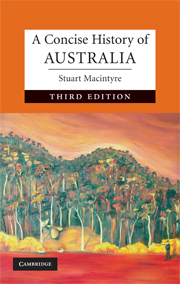Book contents
- Frontmatter
- Contents
- List of illustrations
- Acknowledgements
- Map 1.1 Australia: the main rivers, cities and towns
- 1 Beginnings
- 2 Newcomers, c. 1600–1792
- 3 Coercion, 1793–1821
- 4 Emancipation, 1822–1850
- 5 In thrall to progress, 1851–1888
- 6 National reconstruction, 1889–1913
- 7 Sacrifice, 1914–1945
- 8 Golden age, 1946–1974
- 9 Reinventing Australia, 1975–2008
- 10 What next?
- Sources of quotations
- Guide to further reading
- Index
9 - Reinventing Australia, 1975–2008
- Frontmatter
- Contents
- List of illustrations
- Acknowledgements
- Map 1.1 Australia: the main rivers, cities and towns
- 1 Beginnings
- 2 Newcomers, c. 1600–1792
- 3 Coercion, 1793–1821
- 4 Emancipation, 1822–1850
- 5 In thrall to progress, 1851–1888
- 6 National reconstruction, 1889–1913
- 7 Sacrifice, 1914–1945
- 8 Golden age, 1946–1974
- 9 Reinventing Australia, 1975–2008
- 10 What next?
- Sources of quotations
- Guide to further reading
- Index
Summary
After the chronic political instability that marked the conservative collapse and then the feverish pace of the truncated Whitlam regime, the years afterwards present an outward appearance of equilibrium. Between 1975 and 1991 there was just one change of government, and two prime ministers held office for roughly equal terms. Both in their own ways were striving for the security the electorate desired, and both held to the middle ground.
Yet in the circumstances that now prevailed there could be no security without upsetting the ingrained habits of the past. One preferred confrontation and the other consensus as the way to achieve change, but the change they forced was never sufficient. There was always a need to go further, to abandon yet another outmoded practice and take on additional innovation. Both leaders employed their considerable personal authority to advance the process. Both were condemned as soon as they lost office for excessive timidity and insufficient leadership. In the pursuit of a constantly receding goal of competitive efficiency, Australians were subjected to an unending process of national reinvention.
The first of these leaders was Malcolm Fraser, who headed a Liberal–National Party coalition from 1975 to 1983. The tall, lean scion of a pastoral dynasty from the Liberal heartland of Victoria, he was educated at private schools and Oxford University. A shy, awkward manner was commonly interpreted as patrician aloofness.
- Type
- Chapter
- Information
- A Concise History of Australia , pp. 243 - 301Publisher: Cambridge University PressPrint publication year: 2009

